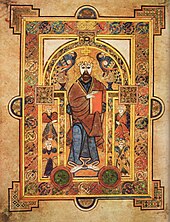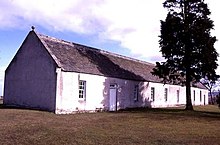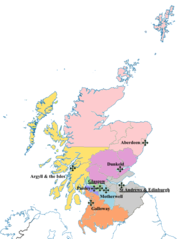Catholic Church in Scotland
Throughout the nearly three centuries of religious persecution and disenfranchisement between 1560 and 1829,[2][3] many students for the priesthood, such as John Ogilvie, Angus Bernard MacEachern, and Alexander Cameron, went abroad to study, others remained in Scotland and, in what is now termed underground education, attended strictly illegal seminaries.After multiple arson attacks by government troops, Scalan was rebuilt in the 1760s by Bishop John Geddes, who later became Vicar Apostolic of the Lowland District and a well-known figure in the Edinburgh intelligentsia during the Scottish Enlightenment.During the 1960s, Frank O'Connor explained that the reason why, on both sides of the Irish Sea, abbots were often more significant than bishops is because a Church governed by an Episcopal polity, "in a tribal society was a contradiction in terms.[21][22][23] Despite the ongoing religious persecution and expulsion from their monasteries and convents of "Romanists" like St Mo Chota, who opposed how much the Celtic Church had been, "absorbed by the tribal system" and lost its independence from control by local secular rulers,[24] at least some of these issues had been resolved on both sides of the Irish Sea by the mid-seventh century.Through the influence of his Hungarian-born wife, St Margaret of Scotland, a clearly defined hierarchy of diocesan bishops and parochial structure for local churches, in line with the queen's experiences in Continental Europe, was developed.According to George Scott-Moncrieff, "Such men were naturally opposed to administrative reform and as naturally enthusiastic for a revolution that would make them absolute possessors of property to which otherwise they would only claim the life-rent..." For this and similar reasons, many Scottish Catholic priests and monks who were also Renaissance humanists, such as Archbishop Andrew Forman, Quintin Kennedy, and Ninian Winzet, "felt bitterly the failure of their fellow clergy to live the life they proclaimed", and called for an internal restoration of Christian morality, that would later be dubbed the Counter-Reformation.As often happens in cases of religious persecution of any kind, efforts by the Hierarchy of the Church to enforce the traditional principle of Canon law that "error has no rights" and treat Protestantism as a criminal offense triggered a widespread public backlash.In particular, after he was sentenced to death for his belief in Lutheranism following an Ecclesiastical trial presided over by Archbishop James Beaton and burned at the stake at St. Andrews in 1528, it was said that the "reek [that is, smoke] of Master Patrick Hamilton infected as many as it blew upon".[32] The subsequent suppression of monasteries, ban on religious orders, and, most particular, the iconoclasm and book burnings at monastic libraries that often accompanied them has recently been criticised, even by non-Catholic historians, as the destruction of Scotland's cultural inheritance.According to historian George Scott-Moncrieff, "The collapse of the secular clergy, many of whom renounced their vows and married, while three bishops apostatised and the rest retired in confusion, left only a few who travelled through the country disguised as laymen trying to succour whom they could.The incident infuriated King Charles I, who sent a furious letter about it to Privy Council of Scotland on 10 December 1630 and was followed by unsuccessful efforts to summon the Highland nobleman to Inverary for criminal prosecution.[38] After the reformed kirk took over the existing structures and assets of the Church, the 1567 overthrow of Mary, Queen of Scots, and the defeat of the armies seeking her restoration during the 1570s, the Vatican reclassified Scotland as a missionary territory and therefore subject to the Congregation for the Propaganda of the Faith.Their focus at first was mainly on evangelising the nobility and courtiers, which led them into involvement in seeking to end the religious persecution of the Church through a series of complex regime change plots and political entanglements, which were covertly opposed from London by Lord Burghley and Sir Francis Walsingham.He was arrested by the Anglo-Catholic Archbishop of St. Andrews, John Spottiswoode and, in a deeply ironic parallel to the religious persecution of the Presbyterian Covenanters during the later events known as The Killing Time, Ogilvie was hanged for refusing to take the Oath of Supremacy and declare that the King was Supreme Head of the Church at Glasgow Cross on 10 March 1615."[54] "Heather priest" Fr Alexander Cameron's biographer Thomas Wynne alleges that these official orders actually preceded Culloden, "A proclamation was on 6th December 1745, putting into operation certain laws which were more or less obsolete - the Act of Queen Elizabeth, cap."[55] The Hanoverian atrocities that followed were motivated by what American Civil War historian Thomas Lowry has termed "the European tradition … that to victors belong the spoils - the losers could expect pillage and plunder",[56] and that enemy civilians are "grist for the mills of more hardheaded conquerors such as Genghis Khan, Tamerlane, and Ivan the Terrible.Father James Grant, who was missionary then, and afterward Bishop, being informed of the threats in a safe retreat in which he was in a little island, surrendered himself, and was carried prisoner to Mingarry Castle on the Western coast (i.e. Ardnamurchan) where he was detained for some weeks."[58] After long and cruel imprisonment with other Catholic priests at Inverness Gaol and in a prison hulk anchored in the River Thames, Grant was deported to the Netherlands and warned never to return to the British Isles.[61] According to Marcus Tanner, "As the Reformed Church faltered in the urban and increasingly industrialised Lowlands, Presbyterianism made its great breakthrough among the Gaelic Highlanders, virtually snapping cultural bonds that had linked them to Ireland since the lordship of Dalriada.The Highlands, outside tiny Catholic enclaves like in South Uist and Barra, took on the contours they have since preserved - a region marked by a strong tradition of sabbatarianism and a puritanical distaste for instrumental music and dancing, which have only recently regained popular acceptance".[62] The pioneering Victorian era folklorist and Celticist John Francis Campbell of Islay (Scottish Gaelic: Iain Òg Ìle) and his many assistant collectors had very different reasons for criticising what they saw as the unnecessary excesses of the Calvinisation of the Highlands and Islands.Apart from inflicting a peculiarly censorious and dour version of Christianity on the population, they are charged with imbuing them with ultra-Calvinist pessimism and political passivity, and with encouraging them to dwell on trivial points of doctrine while their communities were being laid waste by the landlords.[78][79] In addition to Bishop MacDonnell, there were many other "heather priests", such as William Fraser, Angus Bernard MacEachern, and Ranald Rankin, the composer of the famous Gaelic Christmas carol Tàladh Chrìosda, who similarly followed their evicted and voluntary émigré parishioners into the Scottish diaspora during the Clearances.[80] For very similar reasons, Odo Blundell commented ruefully in 1909 that the language, customs, and oral tradition of once densely populated and overwhelmingly Catholic Strathglass were better preserved in Nova Scotia than in Scotland.[81] After receiving his post following the 1878 Restoration of the Hierarchy and during the last decade of the Clearances, Bishop Angus MacDonald of the Diocese of Argyll and the Isles led by example during the height of the Highland Land League agitation.A further influence was the knowledge that the roots of the Clearances lay in the Classical Liberalism preached in Adam Smith's The Wealth of Nations during the Scottish Enlightenment and in that ideology's hostility to, "bigotry and superstition"; which were, in 18th- and 19th-century Scotland, routinely used as shorthand for Roman Catholicism.[88] The same community saw regular outbreaks of violence in the pubs on the paydays of local Irish navvies and the first of many serious anti-Irish riots that negatively affected Dumbarton's reputation after Protestant shipwrights listened to a sermon by visiting anti-Catholic preacher and polemicist John Sayers Orr in October 1855.[96] In 1923, the Church of Scotland produced a (since repudiated) report, entitled The Menace of the Irish Race to our Scottish Nationality, accusing the largely immigrant Catholic population of subverting Presbyterian values and of spreading drunkenness, crime, and financial imprudence.[130] In recent years the Catholic Church in Scotland has experienced negative publicity in the mainstream media due to statements made by bishops in defence of traditional Christian morality and in criticism of secular and liberal ideology.[131] Criticism was also levelled at perceived intransigence on joint faith schools and threats to withdraw acquiescence unless guarantees of separate genders having different staff rooms, toilets, gyms, visitor, and pupil entrances were not met.












Juan Correa de VivarCatholicScriptureCatholic theologyPolityEpiscopalGovernanceFrancisPresidentHugh GilbertApostolic NuncioMiguel Maury BuendíaScotlandEnglishSaint NinianSaint MungoSaint ColumbaChristianity in Roman BritainMedieval ChristianityChurch of ScotlandCatholic Church by countryAfricaAlgeriaAngolaBotswanaBurkina FasoBurundiCameroonCape VerdeCentral African RepublicComorosDemocratic Republic of the CongoRepublic of the CongoDjiboutiEquatorial GuineaEritreaEswatiniEthiopiaGambiaGuineaGuinea-BissauIvory CoastLesothoLiberiaMadagascarMalawiMauritaniaMauritiusMoroccoMozambiqueNamibiaNigeriaRwandaSão Tomé and PríncipeSenegalSeychellesSierra LeoneSomaliaSomalilandSouth AfricaSouth SudanTanzaniaTunisiaUgandaZambiaZimbabweAfghanistanBangladeshBhutanBruneiCambodiaEast TimorHong KongIndonesiaKazakhstanNorth KoreaSouth KoreaKyrgyzstanMalaysiaMaldivesMongoliaMyanmarPakistanPhilippinesSingaporeSri LankaTaiwanTajikistanThailandTurkmenistanUzbekistanVietnamMiddle EastArmeniaAzerbaijanBahrainCyprusGeorgiaAbkhaziaIsraelJordanKuwaitLebanonPalestineSaudi ArabiaTurkeyUnited Arab EmiratesEuropeAlbaniaAndorraAustriaBelarusBelgiumBosnia and HerzegovinaBulgariaCroatiaCzechiaDenmarkEstoniaFinlandFranceGermanyGreeceHungaryIcelandIreland